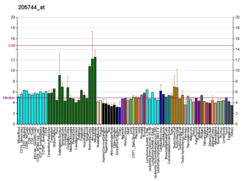| DOC2A |
|---|
|
| Available structures |
|---|
| PDB | Ortholog search: PDBe RCSB |
|---|
|
|
| Identifiers |
|---|
| Aliases | DOC2A, Doc2, double C2 domain alpha |
|---|
| External IDs | OMIM: 604567; MGI: 109446; HomoloGene: 2657; GeneCards: DOC2A; OMA:DOC2A - orthologs |
|---|
| Gene location (Human) |
|---|
 | | Chr. | Chromosome 16 (human)[1] |
|---|
| | Band | 16p11.2 | Start | 30,005,514 bp[1] |
|---|
| End | 30,023,270 bp[1] |
|---|
|
| Gene location (Mouse) |
|---|
 | | Chr. | Chromosome 7 (mouse)[2] |
|---|
| | Band | 7|7 F3 | Start | 126,446,588 bp[2] |
|---|
| End | 126,451,877 bp[2] |
|---|
|
| RNA expression pattern |
|---|
| Bgee | | Human | Mouse (ortholog) |
|---|
| Top expressed in | - right frontal lobe
- right hemisphere of cerebellum
- Brodmann area 9
- left testis
- right testis
- anterior cingulate cortex
- prefrontal cortex
- right uterine tube
- amygdala
- mucosa of transverse colon
|
| | Top expressed in | - ventromedial nucleus
- cingulate gyrus
- primary motor cortex
- motor neuron
- lumbar subsegment of spinal cord
- anterior amygdaloid area
- piriform cortex
- barrel cortex
- prefrontal cortex
- paraventricular nucleus of hypothalamus
|
| | More reference expression data |
|
|---|
| BioGPS |  | | More reference expression data |
|
|---|
|
| Gene ontology |
|---|
| Molecular function | - calcium-dependent phospholipid binding
- clathrin binding
- calcium ion binding
- syntaxin binding
- protein binding
| | Cellular component | - neuron projection
- lysosome
- synapse
- synaptic vesicle membrane
- membrane
- cytoplasmic vesicle
- plasma membrane
- nucleus
- nucleolus
- cell junction
- exocytic vesicle
- extrinsic component of synaptic vesicle membrane
| | Biological process | - nervous system development
- regulation of calcium ion-dependent exocytosis
- synaptic vesicle exocytosis
- exocytosis
- chemical synaptic transmission
- calcium ion-regulated exocytosis of neurotransmitter
- vesicle fusion
- spontaneous neurotransmitter secretion
| | Sources:Amigo / QuickGO |
|
| Orthologs |
|---|
| Species | Human | Mouse |
|---|
| Entrez | | |
|---|
| Ensembl | | |
|---|
| UniProt | | |
|---|
| RefSeq (mRNA) | |
|---|
NM_001282062
NM_001282063
NM_001282068
NM_003586 |
| |
|---|
NM_010069
NM_001368355
NM_001368356
NM_001368357
NM_001368358 |
|
|---|
| RefSeq (protein) | |
|---|
NP_001268991
NP_001268992
NP_001268997
NP_003577 |
| |
|---|
NP_034199
NP_001355284
NP_001355285
NP_001355286
NP_001355287 |
|
|---|
| Location (UCSC) | Chr 16: 30.01 – 30.02 Mb | Chr 7: 126.45 – 126.45 Mb |
|---|
| PubMed search | [3] | [4] |
|---|
|
| Wikidata |
| View/Edit Human | View/Edit Mouse |
|

















